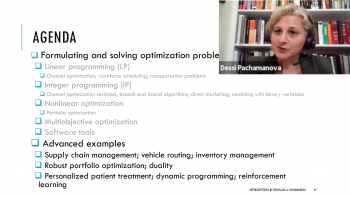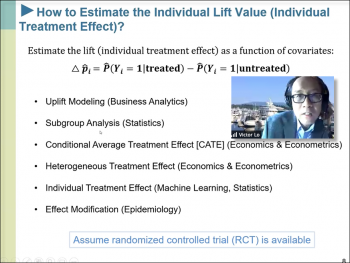


One of the special capacities of NISS is to find experts who are willing to share valuable knowledge and experience of cutting-edge approaches that help others understand and tackle unique statistical issues. This tenth and final Essential Data Science for Business session is no exception. (see Event page) Victor Lo (Fidelity Investments) and Dessislava Pachamanova (Babson College) bring incredible insight to teaching this final topic. Victor is a recognized leader in aspects of statistics, data science and consulting in a wide array of business areas. He is actively engaged with causal inference and is a pioneer of Uplift/True-lift modeling, a key subfield of data science. Dessi is Professor and Zwerling Family Endowed Research Scholar at Babson College and Research Affiliate at the Massachusetts Institute of Technology. She is actively involved in research and consulting about the interface of predictive and prescriptive analytics, optimization under uncertainty, and other topics presented in this tutorial. She has authored numerous research publications, cases, and books, and has extensive experience in teaching at the graduate, undergraduate, and executive education levels. Victor and Dessi donated their time to design this tutorial especially for the benefit of up and coming graduate students, as well as experienced statistics researchers and practitioners who can find ideas for future research at the intersection of several analytical fields.
The Topics
The material that is presented in this session is clearly new, so new in fact that is more than likely will not be found in any formal program of study of statistics or data science!
The topics of this tutorial session were presented in three parts. The first section introduced prescriptive analytics, explaining how this fits into analytics overall. This led to a description of optimization, framed as an important prescriptive analytics tool. This was followed by a number of examples formulating and solving optimization problems and the resources for doing this. The second section examined more advanced applications looking at the transition from predictive into prescriptive analytics and how the tools are integrated together. The final section provided both a practitioner’s and a statistician’s perspective on prescriptive analytics leading to the description of a novel causal prescriptive framework.
Examples from multiple application areas such as marketing analytics, operations management, workforce management, finance, and healthcare were referenced in the context of introducing key optimization concepts and tools such as problem formulation and determination of optimal solutions, types of optimization problems (e.g., linear and integer programming problems), data-driven optimization and optimization under uncertainty. The tutorial presented a practical framework that links predictive analytics, causal inference, and prescriptive analytics for optimizing decisions using appropriate techniques in different situations.
Access to Materials
The Essential Data Science for Business tutorials provide so many details! Models, methods, software, examples! If you were not able to attend this live session you can still access a recording of the session. Use the Registration Option "Post Session Access" on the event webpage, pay the $35 fee, and NISS will provide you with access to all the materials for this session. Or register for the full series of ten tutorials, and NISS will provide all the links to all of sessions in the Data Science series.
